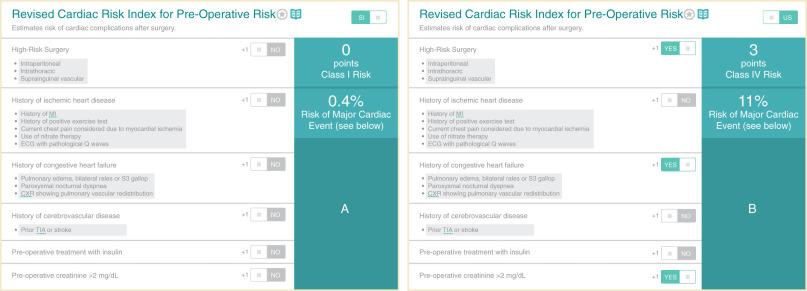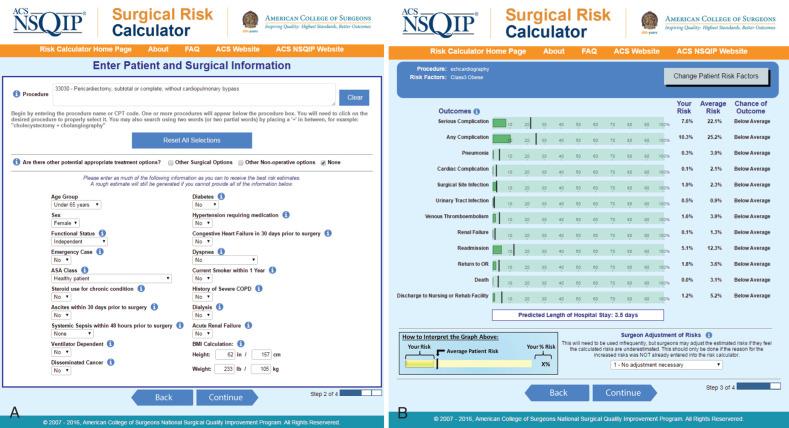Physical Address
304 North Cardinal St.
Dorchester Center, MA 02124
Preoperative assessment of the cardiac patient undergoing noncardiac surgery includes risk assessment for major adverse cardiac events (MACEs).
Categorizing risk for MACEs is dependent on patient risk factors, including the noncardiac procedure, patient age, emergent status of the procedure, preexisting organ dysfunction, and independence in daily activities.
Cardiac risk model calculators exist to facilitate quantification of risk and aid the perioperative physician with optimizing patient care.
The 2014 American College of Cardiology (ACC)/American Heart Association (AHA) guideline document of perioperative cardiovascular evaluation and management of patients undergoing noncardiac surgery provides a valuable stepwise approach to the care of the patient with cardiovascular disease presenting for noncardiac surgery.
Within the 2014 ACC/AHA guideline document are important updates related to the perioperative administration of various cardiac-related medications.
Antiplatelet therapy and the temporal relationship between percutaneous coronary interventions (PCIs) and scheduled surgery determine timing of and perioperative management during noncardiac surgery.
The 2016 ACC/AHA guideline focused update on duration of dual antiplatelet therapy (DAPT) in patients with coronary artery disease provides important updates related to the timing of surgery and management of DAPT after PCI.
No specific recommendations are available regarding transfusion and the decision to transfuse; the hemoglobin goal is decided by the perioperative team.
Pulmonary arterial hypertension and subsequent right ventricular dysfunction are a major cause of poor perioperative outcomes, and the perioperative team should optimize ventilation/perfusion matching and reduce pulmonary vascular resistance.
Patients undergoing surgery experience a well-described stress response of sympathetic nervous system activation, insulin resistance, cytokine production, leukocyte demargination, and pituitary hormone secretion. These physiologic changes, in addition to preexisting patient comorbidities, surgical complexity, and postoperative complications, may contribute to the occurrence of adverse perioperative cardiovascular events in patients undergoing noncardiac surgery. Every patient should undergo an individualized risk assessment to delineate the risks, benefits, and alternatives of surgical intervention as part of a perioperative team approach. In the absence of a net benefit, interventions for optimizing cardiovascular health or consideration of alternative approaches should be performed to ensure the maximum potential benefit at a minimum risk to the patient.
This chapter reviews preoperative cardiac evaluation, including a discussion of common risk calculators, to assist perioperative clinicians with risk assessment and surgical planning. The American College of Cardiology (ACC) and American Heart Association (AHA) clinical practice guideline on perioperative cardiovascular evaluation and management of patients undergoing noncardiac surgery is also reviewed. Recommendations regarding specific and frequently encountered perioperative challenges are discussed, such as medical therapy with β-blockers, angiotensin-converting enzyme (ACE) inhibitors and angiotensin receptor blockers (ARBs), α 2 -agonists, aspirin (including dual antiplatelet therapy [DAPT]), vitamin K antagonists (VKAs), and new oral anticoagulants (NOACs) are addressed. Perioperative management of anemia, pulmonary vascular disease, and right ventricular (RV) dysfunction is also discussed.
Compared with their healthier counterparts, patients with underlying cardiovascular disease have an increased risk of perioperative cardiac complications. This is in part due to the presence of coronary artery disease (CAD), leading to impaired left ventricular ejection fraction (LVEF) and in part due to the physiologic factors associated with surgery that predispose patients to myocardial ischemia. Oxygen supply and demand mismatch may occur secondary to blood loss and hemodynamic changes related to anesthetic administration and surgical stimulation.
Validated algorithms have been developed to determine the cardiovascular risk of mortality and morbidity encountered per patient for each noncardiac operation. Stratification is performed to objectively determine and categorize patients as low, intermediate, or high risk. High-risk patients include those with recent myocardial infarction (MI) or unstable angina, decompensated heart failure (HF), high-grade arrhythmias, or hemodynamically significant valvular heart disease, such as aortic stenosis. These patients are at increased risk for perioperative major adverse cardiac events (MACE), including MI, HF, cardiac arrest, conduction abnormalities, and sudden cardiac death. Certainly, the emergent or urgent status of some surgery plays a large role in estimating risk due to the absence of time for risk assessment and modification. Patients with the high-risk conditions listed are at increased risk of a perioperative cardiovascular event compared with normal, age-matched control participants; however, in most emergent cases, the benefit of proceeding with surgery outweighs the risk of delay to perform additional testing.
The initial preoperative evaluation is typically performed by either a primary care physician or an anesthesiologist, and referral to a cardiologist is warranted if specialized procedures are indicated for life-threatening conditions. Intermediate- or high-risk patients may have angina, dyspnea, syncope, and palpitations, as well as history of heart disease (ischemic, valvular, structural myocardial disease), hypertension, diabetes, chronic kidney disease, and cerebrovascular or peripheral arterial disease. Cardiac functional status may be expressed in metabolic equivalents (METs), as initially determined by the Duke Activity Status Index ( Table 1.1 ). One MET is equivalent to the adult resting oxygen utilization, and an important indicator for MACE after major noncardiac surgery is the preoperative inability to achieve 4 METs or greater, such as by climbing two flights of stairs or walking four city blocks. The decision to pursue cardiovascular or pulmonary testing should be considered only if the results would impact surgical decision making or would likely identify an immediately life-threatening condition requiring timely management.
| Can You… | Weight (in METs) |
|---|---|
|
2.75 |
|
1.75 |
|
2.75 |
|
5.50 |
|
8.00 |
|
2.70 |
|
3.50 |
|
8.00 |
|
4.50 |
|
5.25 |
|
6.00 |
|
7.50 |
Risk model calculators estimate the probability of a perioperative event based on information obtained from the history, physical examination, and surgery type. These models are more applicable for patients at intermediate or high perioperative cardiac risk during noncardiac surgery. Patients at low risk for MACEs should proceed to surgery without further evaluation.
Specific information pertaining to both the patient and the surgery must be provided to appropriately identify individualized risk using a risk calculator. Perioperative information is entered into one or both of two commonly used perioperative risk indices: the Revised Cardiac Risk Index (RCRI) ( Fig. 1.1 ) ( http://www.mdcalc.com/revised-cardiac-risk-index-for-pre-operative-risk ) or the American College of Surgeons' National Surgical Quality Improvement Program (ACS-NSQIP) ( Fig. 1.2 ) surgical risk calculators ( http://site.acsnsqip.org ). The RCRI determines preoperative risk based on risk of surgery, history of ischemic heart disease, congestive heart failure (CHF), cerebrovascular disease, preoperative use of insulin, and creatinine greater than 2.0 mg/dL. The ACS-NSQIP calculator incorporates 20 patient risk factors in addition to the surgical procedure. Surgery-specific risk calculation using RCRI or ACS-NSQIP report the rate of cardiac death or nonfatal MI and are noted to be greater than 5% in high-risk procedures, 1% to 5% in intermediate-risk procedures, and less than 1% in low-risk procedures. Emergency surgery is associated with higher risk of MACEs compared with elective procedures.


After patient risk has been estimated, perioperative physicians and the patient can use the information to proceed with the planned operation, postpone, or modify the treatment plan. Options include proceeding directly with the operative plan, delaying surgery pending further diagnostic evaluation, or changing the planned surgery. This last option may involve altering the surgical plan to a lesser risk procedure, a nonsurgical alternative, or cancelling the operation so that cardiac interventions (e.g., coronary revascularization) can be performed. The risk calculation models are discussed individually in the following section.
In the derivation of the RCRI, 2893 patients undergoing elective major noncardiac operations were monitored for major cardiac complications (death, acute MI, pulmonary edema, ventricular fibrillation or cardiac arrest, and complete heart block) (see Fig. 1.1 ). The index was validated in a cohort of 1422 similar individuals. The predictive value was significant in all types of major noncardiac surgery except for abdominal aortic aneurysm surgery. The RCRI performs well in distinguishing patients at low compared with high risk for all types of noncardiac surgery but is less accurate in patients undergoing vascular, noncardiac surgery. In addition, the RCRI does not predict all-cause mortality well, which is inherent to a risk predictor that does not capture risk factors for noncardiac causes of perioperative mortality.
A universal surgical risk calculator model was developed using a web-based tool consisting of 20 patient factors plus the surgical procedure (see Fig. 1.2 ) and has excellent performance for predicting mortality and morbidity. The ACS-NSQIP has not been validated through external studies, but it remains more comprehensive than the other risk calculators.
After a patient is deemed as being at intermediate or high risk, the ACC/AHA guidelines may then be used to guide further preoperative optimization and perioperative management.
Become a Clinical Tree membership for Full access and enjoy Unlimited articles
If you are a member. Log in here